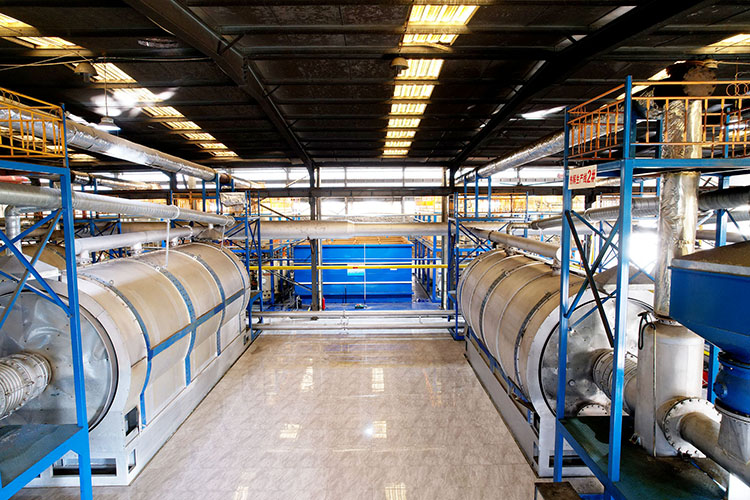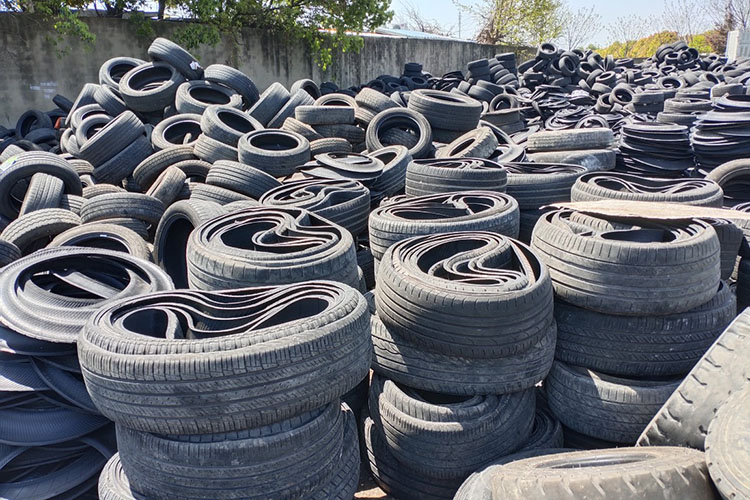Waste tire cracking and refining equipment is a type of equipment that decomposes waste tires into recyclable products through thermal cracking technology. With the increasing awareness of environmental protection and the continuous progress of resource recycling technology, such equipment plays an increasingly important role in the field of waste tire treatment. This article will provide a detailed introduction to the main components, working principles, and significance in environmental protection and resource recovery of waste tire cracking and refining equipment.

The main components of waste tire cracking and refining equipment
1. High temperature anaerobic pyrolysis system
The cracking reactor is the core part of the equipment, where waste tires undergo high-temperature and anaerobic thermal cracking. There are various types of reactor designs, the most common of which are rotary kiln and fixed bed designs. A rotary kiln can ensure uniform heating of materials and improve cracking efficiency, while a fixed bed has the advantages of simple structure and low cost.
2. Heating system
The heating system provides necessary high-temperature conditions for the cracking reactor. Common heating methods include electric heating, gas heating, and fuel heating. Gas and fuel heating typically utilize combustible gases generated during the cracking process, which not only reduces energy consumption costs but also achieves energy self-sufficiency.
3. Condensation system
The cracking gas generated during the cracking process needs to be cooled and condensed into liquid oil through a condensation system. A condensing system typically includes a condenser and a cooling tower. The function of the condenser is to rapidly cool the high-temperature cracking gas, preventing gas escape and environmental pollution. The cooling tower is responsible for cooling the circulating water to ensure the effective operation of the condenser.
4. Oil and gas separation system
The oil and gas separation system is used to separate the liquid cracking oil and combustible gas in the cracking gas. The separated cracked oil can be further refined into products such as diesel and gasoline, while combustible gases can be recycled as heating fuel. This process not only improves resource utilization, but also reduces equipment operating costs.
5. Carbon black treatment system
Carbon black is one of the by-products produced during the cracking process. The carbon black processing system is responsible for collecting and processing these carbon black. Carbon black can be further processed into industrial raw materials, such as pigments, fillers, etc., and is widely used in industries such as rubber, plastics, and ink. The effective utilization of carbon black not only increases economic benefits, but also reduces waste treatment pressure.
6. Steel wire separation system
Waste tires contain a large amount of steel wire, and the steel wire separation system is responsible for separating and collecting these steel wires from the cracking products. The separated steel wire can be recycled and reused for the production of steel, etc. This process not only reduces the amount of waste treatment, but also achieves the recycling of resources.
7. Gas purification system
The waste gas generated during the cracking process needs to be purified to ensure that the emissions comply with environmental standards. Gas purification systems typically include dust collectors, desulfurization towers, and scrubbers. Dust collectors are used to remove particulate matter from exhaust gas, while desulfurization and washing towers are used to remove harmful gases such as sulfur dioxide from exhaust gas. Through the treatment of gas purification systems, the exhaust emissions of equipment can meet environmental requirements and reduce pollution to the environment.
8. Automatic control system
The automatic control system is used to monitor and control various aspects of the cracking process, improving the safety and efficiency of equipment operation. Through the automatic control system, the operating status, temperature, pressure and other parameters of the equipment can be monitored in real time, and automatically adjusted according to the actual situation to ensure the stability and efficiency of the cracking process.
Working principle of waste tire cracking and refining equipment
The working principle of waste tire cracking and refining equipment mainly includes four steps: cracking, condensation, separation, and purification. Firstly, the waste tires are fed into a cracking reactor and undergo thermal cracking under high temperature and anaerobic conditions to generate cracking gas, cracking oil, carbon black, and steel wire products. Then, the cracking gas is cooled and condensed into liquid cracking oil through a condensation system, and the oil gas separation system separates the liquid cracking oil from the combustible gas. Carbon black and steel wire are collected and processed through corresponding processing systems. Finally, the waste gas generated during the cracking process is treated by a gas purification system to ensure that the emissions comply with environmental standards.

The significance of environmental protection and resource recovery of waste tire cracking and refining equipment
The cracking and refining equipment of waste tires is of great significance in environmental protection and resource recovery. Firstly, through high-temperature anaerobic pyrolysis technology, waste tires can be decomposed into recyclable products, reducing the environmental pollution caused by waste tires. Traditional methods for treating waste tires, such as landfill and incineration, not only occupy a large amount of land resources but also generate secondary pollution. In contrast, cracking refining equipment can efficiently convert waste tires into cracking oil, carbon black, and steel wire, with high resource utilization efficiency.
Secondly, cracking refining equipment can achieve energy self-sufficiency. The combustible gas generated during the cracking process can be used as heating fuel for equipment, reducing energy consumption and operating costs. In addition, cracked oil can be further processed into diesel, gasoline, etc., and used as an alternative fuel in transportation and other fields, reducing dependence on traditional petroleum resources.
Finally, the automatic control system and gas purification system of the cracking and refining equipment ensure the safe operation of the equipment and the compliance of exhaust gas emissions. This not only meets environmental requirements, but also improves the operational efficiency and economic benefits of the equipment.
The cracking and refining equipment for waste tires plays an important role in the treatment and resource recycling of waste tires. Through efficient cracking technology and a comprehensive treatment system, the resource utilization and harmless treatment of waste tires can be achieved, reducing environmental pollution and improving resource utilization efficiency. With the continuous advancement of technology and the improvement of environmental protection requirements, waste tire cracking and refining equipment will play a greater role in the future, contributing to environmental protection and sustainable development.
Yongle Environmental Protection is mainly engaged in the research and development, production and sales of complete sets of technical equipment for organic solid waste disposal and comprehensive utilization. Production and manufacturing, domestic waste treatment equipment, tire pyrolysis equipment, medical waste disposal equipment, hazardous waste disposal equipment, and achieve efficient and comprehensive utilization of resources through independently developed low-temperature anaerobic pyrolysis equipment technology solutions.
Tags:Composition of Waste Tire Cracking and Refining Equipment,Yongle Group,Composition of Waste Tire Cracking and Refining Equipment,Yongle Group
 Latest news
Latest news


























